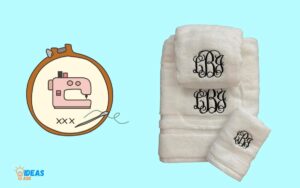How to Remove Mold from Bath Towels? Discover!
To remove mold from bath towels, you’ll need to pre-soak them in a solution of vinegar and water, wash them with hot water and a mold-removing laundry detergent, and finally dry them thoroughly in direct sunlight or a hot dryer.
Mold is a type of fungus that thrives in damp, warm environments, making bath towels an ideal breeding ground. If left untreated, it can cause health issues and damage your towels.
The vinegar solution will help kill the mold spores, while the hot water and special detergent will remove any remaining mold and stains. Thorough drying is essential to prevent future mold growth.
Remember, mold can be harmful to your health and damage your bath towels. Therefore, it’s vital to eliminate it as soon as it’s spotted. The above method is effective and uses mostly household items.
By regularly cleaning and properly drying your towels, you can prevent mold growth and extend the lifespan of your bath towels.

Key Takeaway
Understanding The Importance Of Mold Removal
Understanding the importance of mold removal is crucial, especially when it comes to our bath towels. Learn how to effectively remove mold from bath towels and prevent the growth of harmful bacteria. Keep your towels fresh and clean with these practical tips.
Mold in bathrooms is a common problem that can be harmful to both our health and our belongings. It can thrive in damp and humid environments, making bath towels the perfect breeding ground for mold.
We will explore the health risks associated with mold, the impact it can have on bath towels, and the importance of regular maintenance in preventing mold growth.
Exploring The Health Risks Of Mold:
- Exposure to mold can trigger allergic reactions, including sneezing, coughing, and itchy eyes.
- Prolonged exposure to mold spores can lead to respiratory problems such as asthma and respiratory infections.
- Certain molds release toxins called mycotoxins, which can have severe health effects when inhaled or touched.
Discussing The Impact Of Mold On Bath Towels:
- Mold growth on bath towels can cause musty odors, making them unpleasant to use.
- Mold can weaken the fabric fibers, leading to faster wear and tear.
- Due to their constant exposure to moisture, bath towels can provide an ideal environment for mold to thrive and spread.
Highlighting The Importance Of Regular Maintenance:
- Regularly washing and thoroughly drying bath towels can help prevent mold growth.
- Ensure your towels are completely dry before folding and storing them to avoid trapping moisture.
- Hang towels in a well-ventilated area or use towel hooks to promote air circulation and quick drying.
- Avoid leaving damp towels on the bathroom floor or in a closed laundry hamper, as it creates a breeding ground for mold.
Remember, by understanding the health risks associated with mold, recognizing its impact on bath towels, and implementing regular maintenance practices, you can effectively remove mold from your bath towels and maintain their cleanliness and longevity.
Identifying Mold Growth On Bath Towels
Mold growth on bath towels can be identified by the appearance of dark spots or musty odor. To remove mold, soak the towels in a mixture of vinegar and water, then wash them with bleach in hot water.
Recognizing The Signs Of Mold On Towels:
- Black or dark green spots or stains on the towel surface indicate the presence of mold.
- Musty or unpleasant odor emanating from the towel, especially when damp or after drying, suggests mold growth.
- Texture changes, such as a slimy or fuzzy surface, are common signs of mold infestation.
Understanding The Causes Of Mold Growth:
- Excessive moisture is the primary cause of mold on bath towels. When towels remain damp for extended periods, mold spores can easily multiply.
- Humidity is a contributing factor to mold growth. High humidity in bathrooms creates an ideal environment for mold to thrive on towels.
- Insufficient ventilation prevents proper air circulation, leading to moisture buildup and mold formation on towels.
Explaining How Mold Can Spread:
- Mold spores are microscopic particles that can become airborne, allowing them to travel and settle on different surfaces, including towels.
- Mold can spread from contaminated towels to other laundry items and even to nearby surfaces or storage areas.
- Moisture and dampness provide the conditions for mold growth and its subsequent spread, making it essential to address mold growth promptly.
By recognizing the signs of mold on towels, understanding the causes behind mold growth, and comprehending how it can spread, you are equipped to effectively tackle mold-related issues in your bathroom.
Regularly inspecting your bath towels, taking preventive measures to minimize moisture, and implementing proper drying and washing techniques will help keep your towels mold-free and ensure a clean and healthy bathing experience.
Pre-Treatment Preparations
Preparing your bath towels for mold removal is crucial for effective treatment. Follow these pre-treatment steps to eliminate mold, ensuring clean and fresh towels every time.
To effectively remove mold from bath towels, it is crucial to take proper pre-treatment preparations. This ensures that the process is efficient and reduces the risk of spreading mold spores further.
Follow these steps to gather the necessary supplies, prepare your workspace, and ensure your safety throughout the process.
Gathering The Necessary Supplies:
- Clean bucket or basin: This will be used for soaking the towels.
- Mild detergent: Look for a gentle detergent that is suitable for your towels’ fabric.
- White vinegar: Vinegar’s acidic properties help kill mold and eliminate odor.
- Baking soda: It acts as a natural deodorizer and helps remove stains.
- Gloves: Protect your hands from any potential skin irritation caused by mold.
- Mask: A respiratory mask prevents you from inhaling mold spores during the cleaning process.
- Scrub brush or sponge: Use these tools to scrub away mold from the towels.
- Sunlight or a dryer: Drying the towels under direct sunlight or using a dryer at the highest temperature will kill any remaining mold.
Preparing The Workspace:
- Well-ventilated area: Choose an area with proper ventilation to minimize exposure to mold spores.
- Waterproof surface: Place a waterproof mat or use a bathtub as your workspace to prevent water damage.
- Adequate lighting: Ensure that the area is well-lit, allowing you to identify and target mold growth accurately.
- Access to running water: Easy access to water will facilitate the cleaning process.
Discussing Safety Precautions:
- Ventilation: Open windows and doors or use a fan to maintain air circulation while cleaning.
- Protective clothing: Besides gloves and a mask, consider wearing old clothes that can be easily washed or discarded afterward.
- Eye protection: Wear safety goggles to shield your eyes from mold spores and cleaning solutions.
- Disposal bag: Use a sturdy bag to dispose of any contaminated materials safely.
- Avoid cross-contamination: Clean the workspace thoroughly after finishing to prevent spreading mold to other areas.
Remember, pre-treatment preparations are crucial before dealing with mold on bath towels. Now that you have gathered the necessary supplies, prepared your workspace, and considered safety precautions, you are ready to tackle the mold removal process.
Effective Mold Removal Methods
Easily remove mold from bath towels using these effective methods for a cleaner and healthier home. Follow these simple steps to ensure mold-free towels and prevent further growth.
Mold can be a stubborn problem, especially when it starts appearing on your bath towels. Not only does it look unsightly, but it can also create an unpleasant odor. Thankfully, there are effective methods for removing mold from bath towels.
Keep reading to discover these techniques:
Washing Towels With Hot Water And Bleach:
- Use hot water setting on your washing machine: Set your machine to the hottest water temperature recommended for your towels.
- Add bleach to the wash cycle: Measure the appropriate amount of bleach according to the product instructions and add it to the detergent dispenser.
- Wait for the cycle to finish: Let the washing machine complete the wash cycle before transferring the towels to the dryer.
- Dry the towels thoroughly: Use the high heat setting on your dryer to make sure the towels are completely dry.
Using Vinegar And Baking Soda For Mold Removal:
- Fill your washing machine with hot water: Set the machine to the highest water level suitable for your towels.
- Add vinegar: Pour one cup of distilled white vinegar into the water.
- Toss in the towels: Place the affected towels into the washing machine and let the cycle run.
- Add baking soda during the rinse cycle: Sprinkle half a cup of baking soda into the water during the rinse cycle.
- Dry the towels completely: Once the cycle is finished, transfer the towels to the dryer and make sure they are fully dry.
Exploring Alternative Natural Cleaning Solutions:
- Tea tree oil: Mix one teaspoon of tea tree oil with one cup of water in a spray bottle. Spray the affected areas and let it sit for at least an hour before washing as usual.
- Hydrogen peroxide: Dilute hydrogen peroxide with water in a 1:1 ratio and spray it onto the moldy towels. Allow it to sit for 10 minutes, then rinse and wash.
- Lemon juice and salt: Sprinkle salt onto the moldy areas and squeeze fresh lemon juice over it. Scrub gently and rinse the towels thoroughly.
- Grapefruit seed extract: Add a few drops of grapefruit seed extract to a spray bottle filled with water. Spray the towels and let it sit for a few hours before washing.
By following these effective mold removal methods, you can say goodbye to moldy bath towels. Remember to choose the method that suits your needs and preferences, and always make sure to dry your towels thoroughly to prevent any further mold growth.
Drying And Storing Cleaned Towels
Learn how to effectively remove mold from bath towels and ensure they are properly dried and stored to prevent future growth.
Follow these simple steps to keep your towels clean and mold-free.
Properly Drying Towels To Prevent Mold Recurrence:
After washing your towels, it’s crucial to dry them thoroughly to prevent any mold from returning.
Here are some effective methods to ensure your towels are properly dried:
- Hang towels in a well-ventilated area: Air circulation is key to drying towels effectively. Find a spot where air can freely circulate around the towel, such as a clothesline or towel rack.
- Avoid damp or dark spaces: Mold thrives in moist environments, so it’s essential to keep your towels away from areas prone to dampness, like basements or bathrooms without proper ventilation.
- Ensure towels are completely dry: Before storing your towels, make sure they are completely dry. Check for any residual moisture, especially in thicker towels, as they may take longer to dry.
- Use a dryer on a low heat setting: If you prefer using a dryer, set it to a low heat setting, as high heat can damage the fibers and make towels more susceptible to mold growth.
- Shake the towels to remove excess moisture: Give your towels a good shake before hanging or placing them in the dryer. This helps to remove any excess moisture and facilitate faster drying.
Storing Towels In A Mold-Resistant Manner:
Once your towels are fresh and dry, it’s essential to store them properly to prevent mold from reappearing.
Here’s how you can store your towels in a mold-resistant manner:
- Choose a well-ventilated area: Select a storage space that allows air to circulate freely, reducing the chance of moisture buildup. Avoid storing towels in airtight containers or plastic bags.
- Opt for open shelving or towel racks: Open shelves or towel racks provide better ventilation than closed cabinets or drawers. Consider using these options to store your towels in a mold-resistant manner.
- Avoid storing damp towels: Ensure your towels are completely dry before placing them in storage. Damp towels can contribute to mold growth and must be addressed before storing them away.
- Fold or roll towels for storage: Properly folding or rolling your towels helps to maximize airflow and minimize moisture accumulation. This helps prevent mold growth during storage.
- Consider using moisture-absorbing products: To further inhibit mold growth, place moisture-absorbing products, such as silica gel bags or activated charcoal, near your towel storage area. These products can help absorb excess moisture.
Tips For Maintaining Mold-Free Towels:
To maintain mold-free towels, follow these additional tips:
- Wash towels regularly: Regular washing helps remove any potential mold spores and prevents their accumulation on the fabric. Aim to wash your towels at least once every week or two, depending on their usage.
- Avoid using fabric softeners: Fabric softeners can leave residues that trap moisture, making towels more susceptible to mold. Instead, use vinegar in the fabric softener dispenser to naturally freshen and soften your towels.
- Sun-dry your towels periodically: The natural disinfecting properties of sunlight can be beneficial in preventing mold growth. Hang your towels outside on a sunny day to give them an extra dose of freshness.
- Store towels in a clean and dry environment: Ensure the area where you store your towels is clean, dry, and free from any mold or mildew. Regularly clean the storage space to minimize the risk of mold contamination.
- Rotate towel usage: Avoid using the same towel for an extended period without washing. Regularly swapping out towels ensures they have time to dry thoroughly, reducing the chance of mold growth.
By following these proper drying techniques, using mold-resistant storage solutions, and implementing maintenance tips, you can keep your towels clean and mold-free, providing a fresh and cozy experience every time you dry off.
Preventing Mold Growth In The Future
To prevent future mold growth, it’s important to know how to remove mold from bath towels. Follow these tips to eliminate mold and keep your towels clean and fresh.
Mold growth can be a real hassle, especially when it comes to bath towels. To ensure that you don’t have to deal with it again in the future, it is essential to take a proactive approach in preventing mold from taking hold.
By establishing a regular washing routine, ensuring proper ventilation in the bathroom, and exploring other preventive measures, you can keep your bath towels mold-free and fresh for longer.
Establishing A Regular Washing Routine
Maintaining a regular washing routine for your bath towels is crucial in preventing mold growth.
Here are some tips to keep in mind:
- Frequency: Wash your towels at least once a week to prevent the accumulation of moisture, dirt, and oils that can contribute to mold growth.
- Separate towels: Avoid mixing your bath towels with other laundry items to prevent the transfer of bacteria and fungi that may cause mold.
- Hot water and detergent: Use hot water and a quality detergent to kill any existing mold spores on your towels.
- Avoid fabric softeners: While fabric softeners may make your towels smell nice, they can create a film that traps moisture, providing an ideal environment for mold growth. Consider using vinegar as a natural alternative for softening your towels.
Ensuring Proper Ventilation In The Bathroom
Proper ventilation plays a vital role in preventing mold growth, not just on your towels but also in your entire bathroom.
Here’s what you can do:
- Ventilation fan: Install a ventilation fan in your bathroom to remove moisture-laden air. Remember to turn it on during and after showers or baths to reduce humidity levels.
- Open windows: If your bathroom has windows, open them to promote air circulation and reduce humidity. Fresh air can help prevent moisture buildup, discouraging mold growth.
- Keep bathroom doors open: Leaving the bathroom door open allows air to flow freely, aiding in the drying process and preventing mold-friendly conditions.
Exploring Other Preventive Measures
In addition to a regular washing routine and proper ventilation, there are extra steps you can take to further prevent mold growth.
Consider the following preventive measures:
- Drying thoroughly: After using your bath towels, hang them in a well-ventilated area so they can dry completely. Avoid leaving them in a humid bathroom or folded up, as this can create a breeding ground for mold.
- Sunlight exposure: Whenever possible, expose your towels to sunlight as it helps kill mold spores.
- Anti-microbial treatments: Some detergents and laundry additives are specifically designed to inhibit mold growth. Look for products with anti-microbial properties to add an extra layer of protection.
- Regular inspection: Keep an eye out for any signs of mold on your towels or in your bathroom. Early detection allows for prompt action, preventing mold from spreading.
By incorporating these preventive measures into your routine, you can safeguard your bath towels from mold growth and enjoy fresh, clean linens every time. Stay vigilant and attentive to moisture levels, and you’ll be well on your way to mold-free towels.
Conclusion
To effectively remove mold from bath towels, it is essential to act quickly and implement proper cleaning techniques.
Mold not only gives off an unpleasant odor, but it can also pose health risks. Firstly, ensure that the towels are thoroughly washed using hot water and a quality detergent.
Adding vinegar or baking soda to the wash can help eliminate the mold and its odor. Afterward, it is crucial to dry the towels completely and expose them to sunlight whenever possible, as the sunlight’s UV rays are natural mold fighters.
Remember to regularly inspect your towels for any signs of mold and promptly address the issue to prevent it from spreading. By following these steps, you can enjoy fresh and mold-free bath towels that are safe for you and your family to use.






